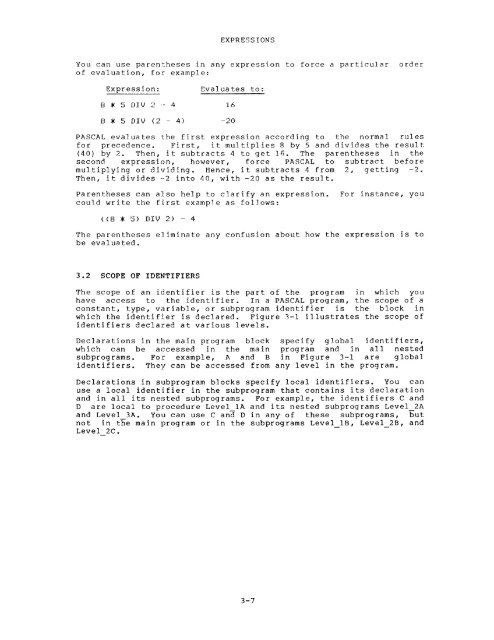TOPS-20 PASCAL Language Manual - Bitsavers
TOPS-20 PASCAL Language Manual - Bitsavers
TOPS-20 PASCAL Language Manual - Bitsavers
You also want an ePaper? Increase the reach of your titles
YUMPU automatically turns print PDFs into web optimized ePapers that Google loves.
EXPRESSIONS<br />
You can use parentheses in any expression to force a particular order<br />
of evaluation, for example:<br />
Expression:<br />
Evaluates to:<br />
8 * 5 DIV 2 ... 4 16<br />
8 * 5 DIV (2 - 4) ····<strong>20</strong><br />
<strong>PASCAL</strong> evaluates the first expression according to the normal rules<br />
for precedence. First, it multiplies 8 by 5 and divides the result<br />
(40) by 2. Then, it subtracts 4 to get 16. The parentheses in the<br />
second expression, however, force <strong>PASCAL</strong> to subtract before<br />
multiplying or dividing. Hence, it subtracts 4 from 2, getting -2.<br />
Then, it divides -2 into 40, with -<strong>20</strong> as the result.<br />
Parentheses can also help to clarify an expression.<br />
could write the first example as follows:<br />
For instance, you<br />
«8 * 5) DIV 2) - 4<br />
The parentheses eliminate any confusion about how the expression is to<br />
be evaluated.<br />
3.2 SCOPE OF IDENTIFIERS<br />
The scope of an identifier is the part of the program in which you<br />
have access to the identifier. In a <strong>PASCAL</strong> program, the scope of a<br />
constant, type, variable, or subprogram identifier is the block in<br />
which the identifier is declared. Figure 3-1 illustrates the scope of<br />
identifiers declared at various levels.<br />
Declarations in the main program block specify global identifiers,<br />
which can be accessed in the main program and in all nested<br />
subprograms. For example, A and B in Figure 3-1 are global<br />
identifiers. They can be accessed from any level in the program.<br />
Declarations in subprogram blocks specify local identifiers. You can<br />
use a local identifier in the subprogram that contains its declaration<br />
and in all its nested subprograms. For example, the identifiers C and<br />
D are local to procedure Le~el lA and its nested subprograms Level 2A<br />
and Level 3A. You can USE~ C and D i 11 any 0 f these subprog rams, but<br />
not in the main program or in the subprograms Level_lB, Level_2B, and<br />
Level 2C.<br />
3-7
















